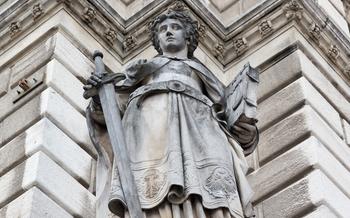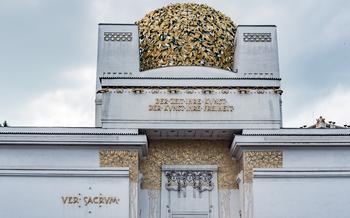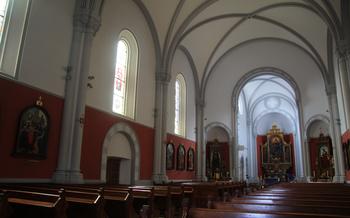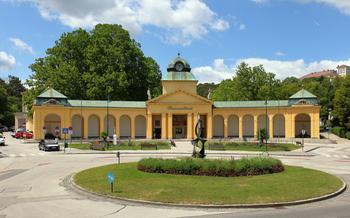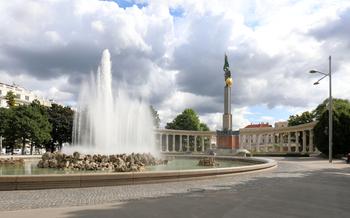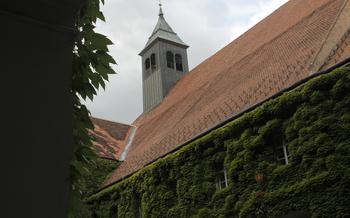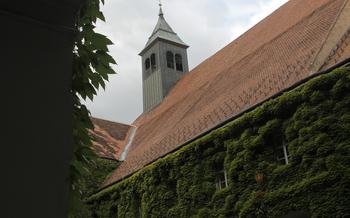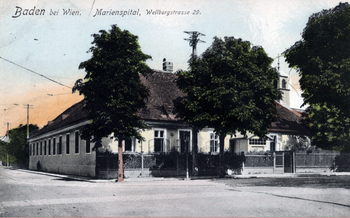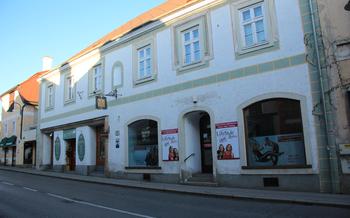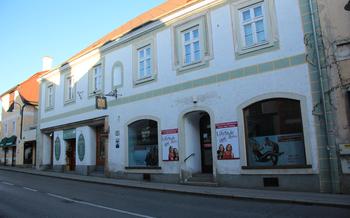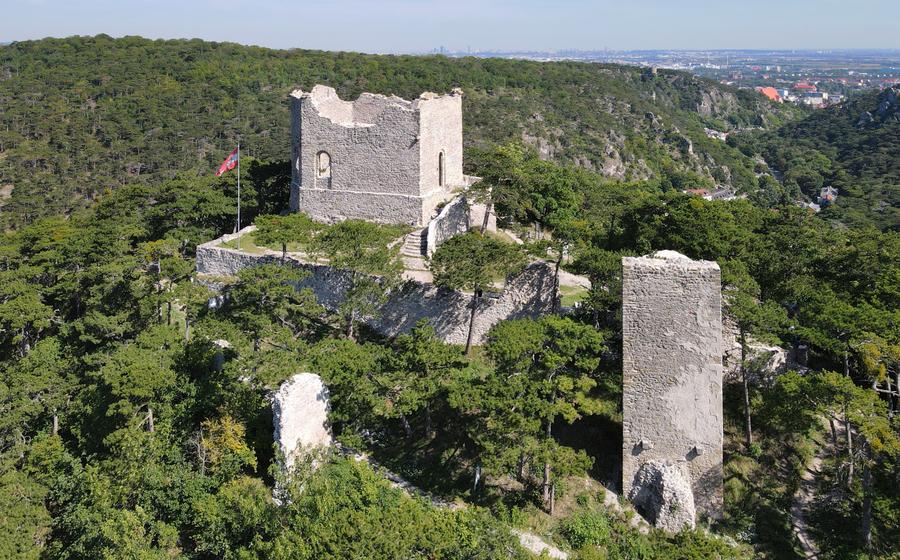
Karl Marx Hof
- Karl Marx Hof: A Historical Landmark
- Location and Transportation
- Guided Tours: Unveiling the History and Significance of the Karl Marx Hof
- Exterior Exploration
- Interior Highlights
- History and Context
- Karl Marx Legacy
- Exhibitions and Events
- Visitor Information
- Surrounding Area
- Personal Experience
- Local Insights
- Architectural Analysis
- Cultural and Social Impact
- Insider Tip: Unveiling Hidden Gems
Karl Marx Hof: A Historical Landmark
The Karl Marx Hof, a monumental residential complex located in Vienna, Austria, stands as an architectural marvel and a significant historical landmark. Designed by renowned architects Karl Ehn and Otto Wagner, the complex boasts a remarkable blend of aesthetic beauty, functional design, and symbolic meaning.
The Karl Marx Hof was constructed during the interwar period, a time marked by social and economic turmoil in Austria. It was part of a broader socialist housing movement aimed at providing affordable and quality housing for the working class. The complex's grand scale and innovative design reflected the ideals of social equality, community, and progress.
Beyond its architectural and functional significance, the Karl Marx Hof carries deep symbolic meaning. Named after the renowned philosopher and economist Karl Marx, the complex became a symbol of Marxist ideology and the struggle for social justice. The integration of artwork, sculptures, and murals depicting scenes from the labor movement further emphasized the complex's political and cultural significance.
The Karl Marx Hof stands as a testament to the transformative power of architecture and its ability to embody social and political ideals. It remains a powerful reminder of the struggles and aspirations of the working class and continues to inspire discussions on social equality and urban planning.
Location and Transportation
The Karl Marx Hof is located at Heiligenstädter Straße 82-92, 1190 Vienna, Austria. It is situated in the Heiligenstadt district, in the Döbling part of the city. The complex is easily accessible by public transportation, with multiple options available for visitors. The nearest underground (U-Bahn) station is Heiligenstadt, served by the U4 line. From there, it is just a short walk to the Karl Marx Hof. Additionally, several bus lines stop nearby, including the 35A, 37A, and 38A, providing convenient connections to other parts of the city. The Karl Marx Hof is also accessible by car, with limited on-street parking available in the surrounding area. Visitors can use the nearby parking garage at Heiligenstädter Straße 87 for a more convenient option. Whether arriving by public transportation or private vehicle, the Karl Marx Hof is well-connected and easily accessible for visitors from all over Vienna.
Guided Tours: Unveiling the History and Significance of the Karl Marx Hof
Visitors eager to delve deeper into the historical and cultural significance of the Karl Marx Hof can embark on guided tours that provide an immersive and informative experience. These tours are conducted by knowledgeable guides who share insights into the architectural, historical, and social aspects of the complex. The tours are offered in various languages, ensuring accessibility for visitors from different linguistic backgrounds.
Highlights of the guided tour include an exploration of the complex's unique architectural features, such as its grand entrance, courtyards, and distinctive red-brick facade. Guides provide detailed explanations of the socialist housing movement and its influence on the design and construction of the Karl Marx Hof. They also discuss the historical events and stories associated with the complex, including its role as a shelter for refugees during World War II and its significance as a symbol of social equality and progress.
To book a guided tour, visitors can contact the Karl Marx Hof directly or through authorized tour operators. The tours are typically offered on a regular schedule, with specific dates and times available on the complex's website. Advance booking is recommended to secure a spot and avoid disappointment.
Exterior Exploration
The Karl Marx Hof stands as a testament to the architectural brilliance of its time. Its grand facade, stretching over a kilometer in length, showcases a fusion of Art Deco and Socialist Realist styles. The eye is drawn to the symmetrical composition accented by rhythmic rows of windows. The beige-colored exterior exudes a sense of warmth and solidity, while the red accents add a touch of dynamism.
Unique architectural features such as rounded corners, projecting balconies, and intricate friezes add to the visual interest of the complex. The courtyard, a defining feature of the Karl Marx Hof, provides a glimpse into the community-oriented design. Surrounded by arcades, the courtyard creates a spacious and welcoming environment for residents and visitors alike.
Notable sculptures and decorative elements adorn the exterior, adding symbolic and artistic value. The monumental relief sculptures depicting workers, farmers, and intellectuals pay homage to the socialist ideals that shaped the complex's creation. These intricate works of art provide a visual narrative of the working-class struggle and the hope for a more just and equitable society.
The Karl Marx Hof offers ample photo opportunities for visitors to capture the grandeur and uniqueness of this architectural masterpiece. The sweeping views from the courtyard or the elevated walkways provide a panoramic perspective of the complex, showcasing its scale and the surrounding cityscape. Visitors can also capture close-up details of the sculptures, decorations, and architectural elements that make the Karl Marx Hof a truly remarkable sight.
Interior Highlights
The Karl Marx Hof is not only admired for its exterior but also for its impressive interior spaces. Common areas and public spaces are designed with meticulous attention to detail, featuring intricate mosaic floors, decorative ceilings, and elegant chandeliers. Residential units, though modest in size, are well-planned and functional, showcasing the principles of modern living and communal harmony.
Historical murals and artwork adorn the walls of the complex, adding to its cultural significance. These murals depict scenes from everyday life, the struggles of the working class, and the ideals of socialism. They serve as a reminder of the social and political context in which the Karl Marx Hof was conceived and built.
Each element of the interior contributes to the overall narrative of the Karl Marx Hof, highlighting its commitment to social equality, progress, and the well-being of its residents. Visitors can immerse themselves in the history and culture of the complex by exploring its common areas, residential units, and the various artworks that adorn its interiors.
History and Context
The Karl Marx Hof was constructed between 1927 and 1930 as part of the grand social housing project known as the "Red Vienna" initiative. This ambitious urban development program was spearheaded by the Social Democratic Party of Austria, which sought to address the pressing housing shortage and improve the living conditions of the working class.
Drawing inspiration from socialist ideals of equality and social justice, the Karl Marx Hof epitomizes the aspirations and achievements of this era. The massive housing complex was designed to provide affordable, high-quality housing to working families, with an emphasis on creating a communal and cooperative living environment.
The Karl Marx Hof also played a significant role in the history of Vienna. It served as a refuge for socialists and communists during the tumultuous years of the 1930s, when the rise of fascism posed a grave threat to democratic values and social progress. The housing complex became a symbol of resistance against political oppression and a testament to the resilience of the socialist movement.
Karl Marx Legacy
Karl Marx, the renowned philosopher, economist, and sociologist, is inextricably linked to the Karl Marx Hof housing complex. Marx, born in Trier, Germany, in 1818, dedicated his life to analyzing the capitalist system and advocating for social equality. His seminal work, "Das Kapital," remains a cornerstone of economic thought and has significantly influenced political and social movements worldwide.
The naming of the housing complex after Karl Marx is a testament to the profound impact of his ideas on the socialist housing movement in Vienna. In the early 20th century, Vienna was a hotbed of socialist and communist activity, and the construction of the Karl Marx Hof was seen as a tangible manifestation of Marx's vision for a more just and equitable society.
Marxist ideology, with its emphasis on class struggle and the abolition of private property, resonated deeply with the working-class residents of the Karl Marx Hof. The complex became a symbol of the socialist movement's aspirations for a society free from exploitation and oppression.
However, the association with Karl Marx has also been a source of controversy and debate. Critics have argued that naming the housing complex after a figure who advocated for revolutionary change was divisive and provocative. They have also pointed to the fact that Marx himself never lived in Vienna and had no direct connection to the housing project.
Despite these controversies, the Karl Marx Hof remains a potent symbol of the socialist housing movement and a reminder of Karl Marx's enduring influence on social and political thought. The complex stands as a testament to the power of architecture to embody and communicate ideological ideals, while also sparking ongoing discussions about social justice and equality.
Exhibitions and Events
The Karl Marx Hof is not just a historical landmark but also a vibrant cultural hub that hosts a variety of exhibitions, events, and performances throughout the year. Temporary exhibitions and displays showcase the work of local and international artists, highlighting contemporary art and design. These exhibitions offer visitors a glimpse into the creative spirit of Vienna and provide a platform for emerging talent.
In addition to art exhibitions, the Karl Marx Hof also hosts cultural events and performances that celebrate the rich cultural heritage of the city. From concerts and theater productions to film screenings and literary readings, there is something for everyone to enjoy. These events bring the community together and create a lively atmosphere within the complex.
Educational programs and workshops are also offered at the Karl Marx Hof, providing visitors with an opportunity to learn more about the history, architecture, and cultural significance of the complex. These programs are designed for people of all ages and interests, and they offer a unique way to engage with the history and legacy of the Karl Marx Hof.
Seasonal activities and celebrations are also held throughout the year, adding to the vibrant atmosphere of the complex. During the summer months, the courtyard comes alive with outdoor concerts, film screenings, and family-friendly events. In the winter, the courtyard is transformed into a magical winter wonderland, complete with a Christmas market and ice skating rink.
Visitor Information
The Karl Marx Hof is open to the public and welcomes visitors from all over the world. The opening hours vary depending on the season, but it is generally accessible from 9:00 am to 5:00 pm on weekdays and from 10:00 am to 4:00 pm on weekends. Admission to the courtyard and exterior areas is free of charge, allowing visitors to explore the architectural features and capture stunning photographs.
For those who wish to delve deeper into the history and significance of the Karl Marx Hof, guided tours are available upon request. These tours are conducted by knowledgeable and passionate guides who provide insights into the construction, social context, and cultural impact of the complex. Guided tours are offered in various languages, including English, German, and French, ensuring that visitors from diverse backgrounds can fully appreciate the site's significance.
To book a guided tour, visitors can contact the Karl Marx Hof Visitor Center directly or make a reservation online. The center provides detailed information about tour schedules, pricing, and availability, accommodating individual and group requests. Contact details, including the phone number, email address, and website, are readily available on the Karl Marx Hof's official website. The friendly and helpful staff is always happy to assist visitors with any inquiries or special requests, ensuring a smooth and enjoyable experience.
Surrounding Area
Vienna is a treasure trove of cultural and historical attractions, and the Karl Marx Hof is no exception. Its location in the 23rd district of Liesing places it amidst a vibrant and dynamic part of the city. Visitors can explore nearby landmarks like the Lainzer Tiergarten, a sprawling nature reserve with hiking trails and wildlife encounters.
Just a short walk away, the Perchtoldsdorf Castle offers panoramic views of the surrounding countryside and insights into medieval history. For a taste of modern architecture, the Gasometer shopping and entertainment complex is a must-visit, featuring unique shops, restaurants, and a rooftop terrace with stunning city views.
Strolling along the Liesing river, visitors can immerse themselves in the natural beauty of the area, with lush green parks and tranquil walking paths. The nearby Auhof Center provides a convenient shopping experience with a variety of retail stores and dining options.
Transportation in the area is efficient and accessible, with the U6 subway line connecting the Karl Marx Hof to the city center and other major attractions. Numerous bus routes also serve the area, making it easy to explore the surrounding neighborhoods and landmarks.
Personal Experience
During my visit to the Karl Marx Hof, I was struck by its grandeur and historical significance. As I stepped into the courtyard, I couldn't help but admire the intricate details of the architecture and the sheer size of the complex. It was as if I had been transported back in time to witness the bustling life of its early residents.
One of the highlights of my visit was the opportunity to explore the interior of the Karl Marx Hof. I was particularly impressed by the well-preserved common areas and public spaces, which featured beautiful murals and artwork depicting scenes from daily life and socialist ideals.
As I walked through the residential units, I couldn't help but feel a sense of connection to the past. It was easy to imagine the families who had lived here, their struggles, and their hopes for a better future. The Karl Marx Hof is not just a historical landmark but a testament to the power of collective action and the enduring legacy of social housing.
Local Insights
Unveiling the local perspectives on the Karl Marx Hof offers a deeper understanding of its cultural significance and community stories. To gain insights into the daily life and atmosphere, interviews with local residents and experts provide valuable firsthand accounts. Locals share their personal experiences, memories, and anecdotes associated with the housing complex, shedding light on its evolution and impact on the surrounding neighborhood.
Experts, such as historians, architects, and urban planners, offer their unique perspectives on the Karl Marx Hof's architectural and social significance. They discuss the challenges faced during its construction, the innovative solutions implemented, and the lasting legacy of the complex. Through these local insights, visitors gain a more comprehensive understanding of the Karl Marx Hof beyond its historical importance.
Architectural Analysis
The Karl Marx Hof showcases a distinctive architectural style that blends elements of Art Deco, Socialist Realism, and Viennese Modernism. Its imposing façade, characterized by clean lines and geometrical patterns, reflects the influence of modern architectural trends. The extensive use of red bricks, a hallmark of socialist architecture, adds a sense of warmth and solidity to the building's exterior.
The innovative design principles employed in the Karl Marx Hof set it apart as a remarkable example of urban planning. The courtyard layout, with its central green spaces and communal areas, promotes a sense of community and fosters social interaction among residents. This design concept, often referred to as the "Hof" or courtyard model, became a defining feature of social housing developments in Vienna and beyond.
The complex's unique features, such as its elevated walkways and rooftop terraces, were designed to maximize natural light and fresh air circulation, ensuring a healthier living environment for its occupants. These innovative design elements, combined with the incorporation of communal amenities like laundries, kindergartens, and shops, demonstrate the architects' commitment to creating a comprehensive and self-sufficient living space for the working class.
The Karl Marx Hof's architectural significance extends beyond its individual features. It serves as a testament to the transformative power of architecture as a tool for social change. By providing affordable and high-quality housing for the working class, the complex embodied the ideals of the socialist movement and played a crucial role in shaping the urban landscape of Vienna.
Cultural and Social Impact
The Karl Marx Hof has had a profound cultural and social impact, transcending its role as a mere housing complex. It has become a symbol of social equality and progress, representing the ideals of a just and fair society. The integration of art and architecture within the complex further enhances its cultural significance, creating a unique and inspiring environment for its residents and visitors alike.
The Karl Marx Hof has influenced social housing policies worldwide, serving as a model for affordable and accessible housing solutions. Its innovative design principles and commitment to providing comfortable and healthy living spaces have set a precedent for contemporary urban planning and development.
As a cultural landmark, the Karl Marx Hof attracts visitors from around the globe who come to appreciate its architectural beauty, historical significance, and social message. It has been featured in numerous exhibitions, publications, and documentaries, solidifying its status as a cultural icon of Vienna and a testament to the power of architecture to drive social change.
Insider Tip: Unveiling Hidden Gems
Beyond the main attractions and highlights, the Karl Marx Hof holds a trove of hidden gems waiting to be discovered. Take the time to explore the tranquil courtyards, where the intricate details of the architecture unfold in a serene setting. Look for the small, tucked-away nooks and corners that reveal hidden sculptures, murals, and inscriptions, each telling a unique story.
One insider tip is to visit the rooftop terrace, accessible to the public during certain times. From this vantage point, you can marvel at the stunning panoramic views of Vienna, with its iconic landmarks and sprawling cityscape stretching out before you. It's a perfect spot to capture breathtaking photos and gain a new perspective on the city.
For a deeper dive into the history and stories behind the Karl Marx Hof, consider booking a guided tour led by a local expert. These tours often include access to restricted areas, such as the former communal laundry rooms or the original boiler room, providing a glimpse into the daily life and challenges faced by the residents.
Whether you're a history buff, an architecture enthusiast, or simply seeking a unique experience, the Karl Marx Hof offers a wealth of hidden gems to discover. Take the time to explore beyond the surface and uncover the lesser-known aspects of this remarkable housing complex.
